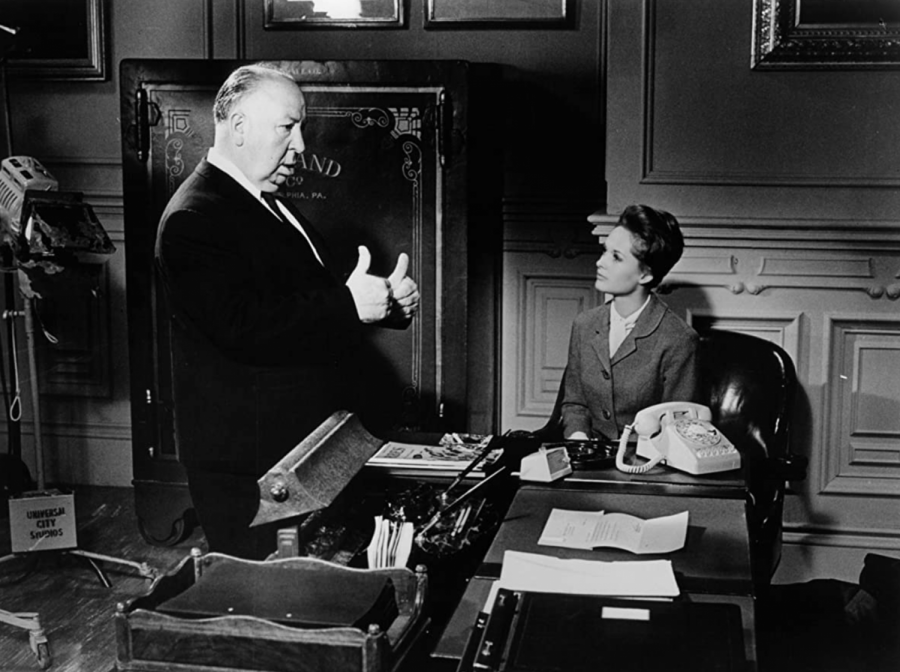Hidden Gem: ‘Marnie’ (1964)
Alfred Hitchcock and Tippi Hedren star in the film “Marnie”. The movie was released on July 22, 1964.
July 13, 2021
I was somewhat surprised when I recently discovered that the late Oscar-winning Italian director (“The Last Emperor”) Bernardo Bertolucci’s favorite Alfred Hitchcock film was the 1964, somewhat disturbing, romantic mystery “Marnie.” This film was underappreciated at the time of its release, and it’s not one of Hitchcock’s very best works. Still, I’ve always admired several of the film’s sequences, which I frequently use to demonstrate suspense for my film classes. So, I decided to give “Marnie” a closer look. “Marnie” stars “Tippi” Hedren, who had just made Hitchcock’s “The Birds,” and Sean Connery, who was taking a short break from the first two James Bond thrillers.
Based on the 1961 Winston Graham novel, “Marnie” is a romantic mystery about a woman with a troubled past and deep psychological problems who is now a compulsive thief. Originally, Hitchcock planned to use Grace Kelly as his lead and offered her return to film after her marriage to Rainier III, Prince of Monaco.
Marion Holland (Hedren) is hired by Sidney Strutt, the owner of a tax consulting company, and within months, she steals $10,000 then disappears. Marion, whose real name is Marnie Edgar, cares for her invalid mother, Bernice, who lives in Baltimore.
Mark Rutland (Connery) is a successful Philadelphia publisher and widower who knows Strutt through business dealings. One day, he hires a woman, Mary Taylor (Marnie’s latest disguise), and begins taking an obvious interest in her. While working one Saturday during thunderstorms, she has a severe panic attack, and Rutland becomes very concerned. Marnie also has an abnormal reaction to bright red-colored things she encounters.
Screenwriter Jay Presson Allen provides more than the usual damsel in distress storyline. As Rutland’s interests become romantic and he clearly manipulates Marnie, his desire to help her with psychological problems seems genuine. Additionally, Allen demonstrates a compelling reason for Marnie’s fear of men and her desire to refuse their sexual advances. Allen’s plot leads to a revealing, surprise ending that seems a bit less than satisfying.
Get The Daily Illini in your inbox!
Yet, the five-minute safe robbery at the Rutland Company is one of Hitchcock’s most skillfully composed and effective suspenseful scenes in all his work. It nicely fits his definition of suspense, which demanded the maximum amount of audience knowledge of the scene’s events to be emotionally involved in the characters. He hated surprise for the sake of shock. In “Marnie,” he combined realistic qualities of the long take and natural use of sound with the more expressionistic qualities of effectively manipulated high- and low-angle shots with quick cuts from multiple perspectives for maximum tension.
The robbery sequence begins at the end of the day as office workers are leaving for the weekend. In the scene’s most neatly composed shot, Hitchcock divides the screen symmetrically, nearly in half, looking down a hallway. The audience views most of the action from a distance. To the left are the empty hallway and other desks on the office floor; to the right in the background is the boss’s office with a large green safe, which Marnie will rob.
Using deep-focus photography and near-total silence while Marnie manipulates the combination and removes cash from the safe, the audience suddenly becomes aware of an old cleaning woman on the left mopping the floor. Marnie looks over her shoulder numerous times as each woman’s actions proceed toward the foreground in the shot. Hitchcock’s editing quickens, and while Marnie realizes the cleaning woman is there but is unaware of her presence, she plans an escape, which includes taking off her high-heeled shoes and placing them in her coat pockets. The tension mounts as Hitchcock gets the viewer to empathize with his troubled heroine as we hope she finds an escape path.
Connery and Hedren have exceptional on-screen chemistry. Connery, known for playing a man’s man such as Rutland, shows much compassion for the troubled Marnie, whom he eventually marries and decides to protect.
In his famous mid-1960s interviews with François Truffaut, Hitchcock admitted to “Marnie”’s shortcomings but noted, “I like ‘Marnie’ very much as it is, but I feel that it’s difficult for the public because of the atmosphere, which is stifling, a little like a nightmare.”
Sadly, “Marnie” marked the end of the collaboration of three longtime members of the creative Hitchcock team. Cinematographer Robert Burks, who shot twelve of Hitch’s films, died in a house fire in 1968. Editor George Tomasini, who cut nine of Hitchcock’s films, had a fatal heart attack in November 1964. And Bernard Herrmann, the composer who added a distinct Hitchcock sound to seven of his films, never worked with the master again after having a falling out on musical plans for Hitchcock’s next film, “Torn Curtain.” Most of Hitchcock’s later films seemed to suffer from this loss of wonderful collaborators.







